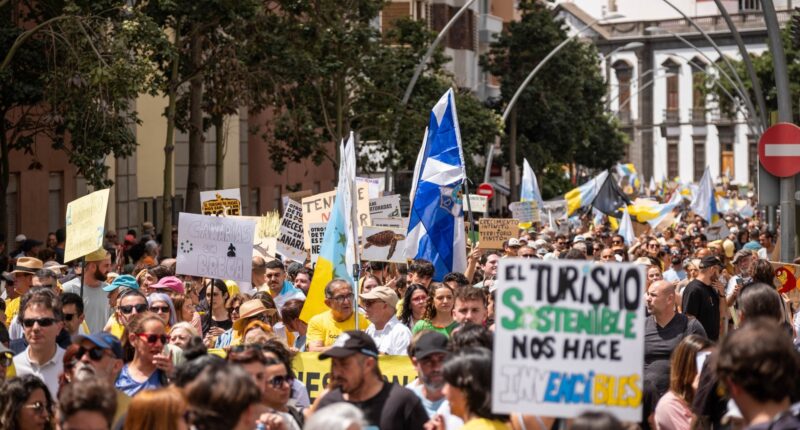Warnings have been issued for British tourists traveling to the Canary Islands as massive anti-tourism demonstrations are anticipated. The upcoming protests are expected to be the most forceful to date.
The demos are expected to hit popular tourist resorts on May Day – just two weeks after thousands of tourism workers protested over Easter.



Protests are planned to take place next Thursday across various locations in the Canary Islands, including Lanzarote, Fuerteventura, La Palma, El Hierro, Paraje Pico de Malpaso, La Gomera, Plaza de las Américas, Santa Cruz de Tenerife, and Las Palmas de Gran Canaria.
Thousands of people are set to demonstrate, under the slogan “Protect what has been conquered, win the future“.
Protests were first organised by workers’ unions, Comisiones Obreras (CCOO) and Unión General de Trabajadores (UGT), but they have now been expanded.
People are encouraged to take to the streets on all of the islands in what campaigners have called “the most forceful” protest to date.
Despite the significant contribution of the Canary Islands to the Spanish GDP, it has the lowest salaries in Spain as reported by CCOO and UGT in the region.
Union leaders held a press conference, blasting the concentration of wealth in the hands of a few, while workers struggle with sky-high rents, low wages and rising living costs.
They condemned the Canary Islands’ healthcare system as “the worst” in Spain, citing the “longest waiting list” and poor working conditions that leave the working class in precarious situations.
Campaigners called on employers in private clinics, agriculture, hospitality and commerce to take responsibility towards workers who “deserve a fair salary, a fair agreement with decent wages”.
The unions urged a mass mobilisation “in defence of social and labour rights” and “in support of the European project as a pillar of social democracy, coexistence and progress”.
“It is time to fight for workers’ rights and to build a retaining wall against the fascist policies that exist at a national and international level,” said Manuel Navarro, the general secretary of UGT.
It comes as thousands of tourism workers in the Canary islands went on strike on Holy Thursday and Good Friday, April 17 and 18.
Representatives of the Tenerife workers’ union – who demanded a rise in pay – said the offer from employers was unacceptable.
The tourism employers’ association, formed by Ashotel and AERO, had offered a four percent increase in pay for workers, hoping it would prevent them from protesting during the Easter holidays.
But unions ask for 6.25 percent.
Meanwhile, Spain’s first anti-tourism protests of the year kicked off on April 5 with vigour, when thousands of anti-tourism protesters flooded the streets of over 40 cities in Spain.
Huge crowds across 40 different Spanish cities took to the streets.
The main issue addressed was soaring rents and a lack of affordable homes.
What are Spain’s anti-tourist protests?

In April 2024, residents across Spain began protesting against overtourism.
Since then, large protests have taken place across the country, especially in tourist areas like the Balearics and Canaries, and cities like Barcelona and Málaga.
In April 2024, between 20,000 and 50,000 people reportedly protested in the Canary islands.
By July, around 50,000 took to the streets in Palma de Mallorca.
Locals say overtourism has reduced their quality of life, increased the cost of living and brought in cheap, “low-quality” tourists who do not contribute to the local economy.
They say the influx of “low-quality” tourism has led to a boom in low-wage, precarious jobs in hospitality and services, while profits go to big hotel chains and landlords, not local workers.
But critics argue that the protests and their messages could be considered ‘tourismphobia’ – an ‘aversion or rejection of tourism’.
Anti-tourism movements have been gaining traction not just in Spain, but across Europe in countries like Italy and Greece.
In response, measures have been implemented across Europe to curb mass tourism.




















